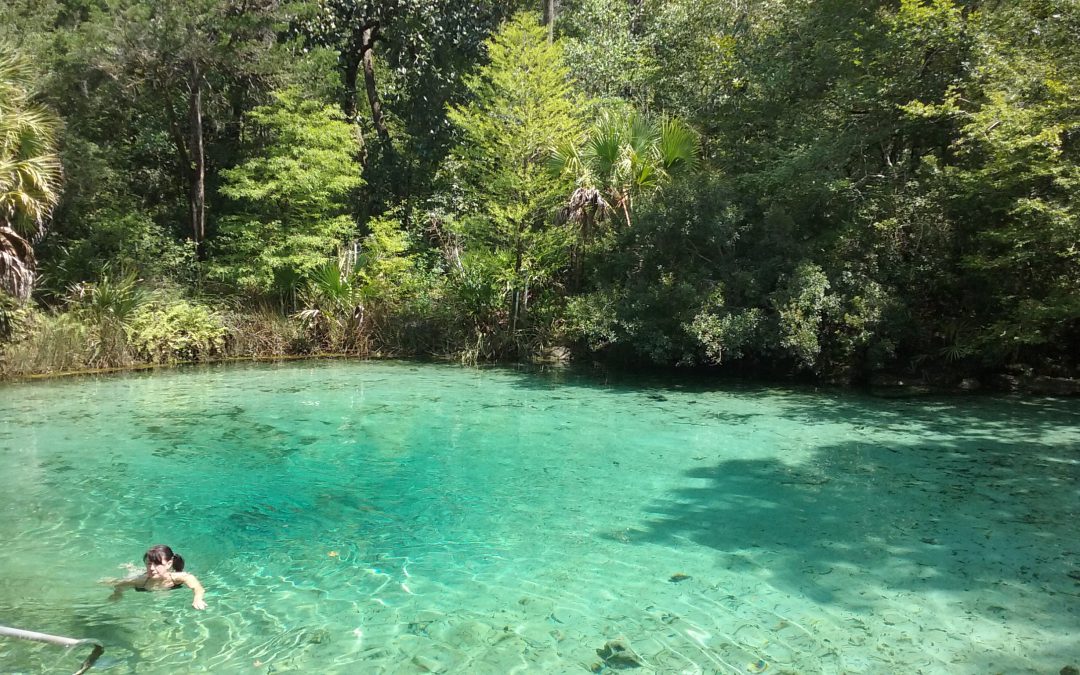
by Andrea Albertin | Apr 9, 2020
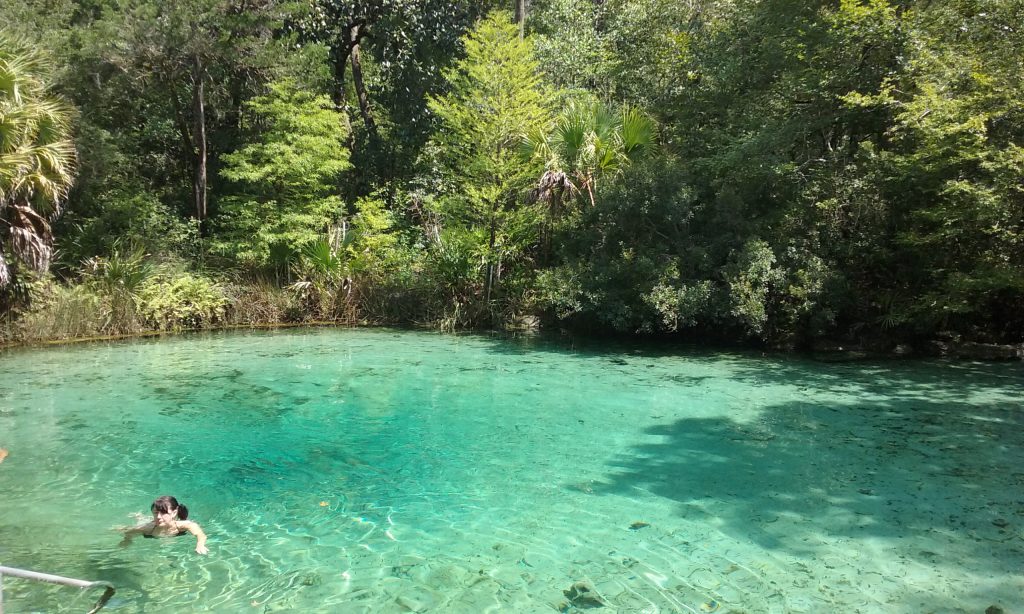
Pitt Spring in the Florida Panhandle is one of more than 1,000 freshwater springs in the state. Springs serve as ‘windows’ to groundwater quality, since the water that flows from them comes largely from the Upper Floridan Aquifer. Photo: A. Albertin
As Florida residents, we are so fortunate to have the Floridan Aquifer lying below us, one of the most productive aquifer systems in the world. The aquifer underlies an area of about 100,000 square miles that includes all of Florida and extends into parts of Alabama, Georgia and South Carolina, as well as parts of the Atlantic Ocean and the Gulf of Mexico (Figure 1). The Floridan Aquifer consists of the Upper and Lower Floridan Aquifer.
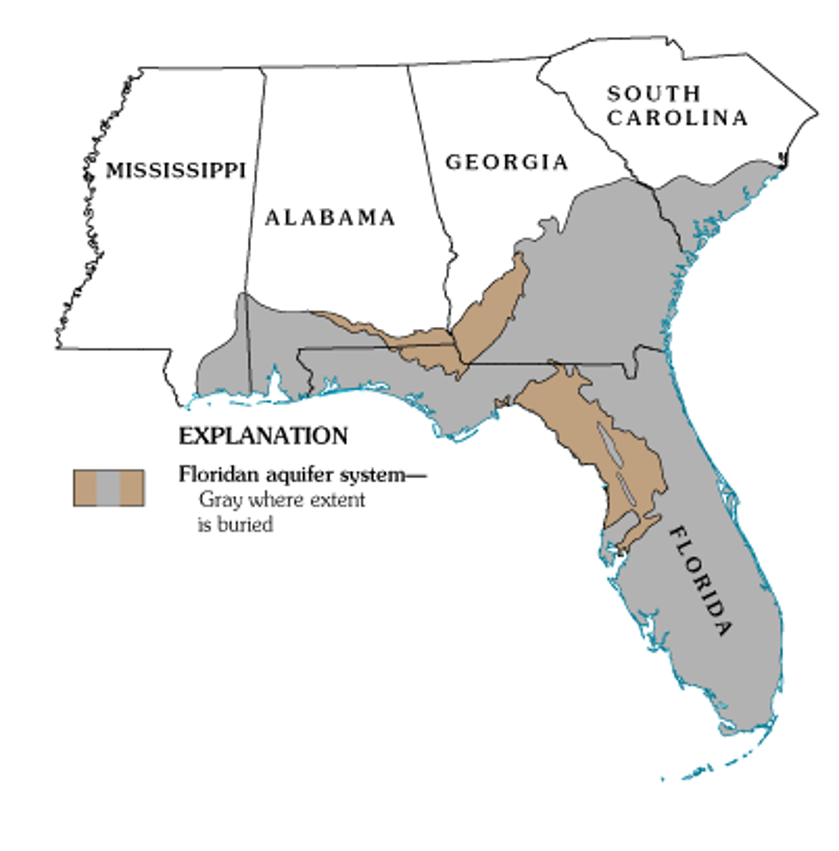
Figure 1. Map of the extent of the Floridan Aquifer. Areas in gray show where the aquifer is buried deep below the land surface, while areas in light brown indicate where the aquifer is at land surface. Many springs in Florida are found in these light brown areas. Source: USGS Publication HA 730-G.
Aquifers are immense underground zones of permeable rocks, rock fractures and unconsolidated (or loose) material, like sand, silt and clay that hold water and allow water to move through them. Both fresh and saltwater fill the pores, fissures and conduits of the Floridan Aquifer. Saltwater, which is more dense than freshwater, is found in all areas of the deeper aquifer below the freshwater.
The thickness of the Floridan Aquifer varies widely. It ranges from 250 ft. thick in parts of Georgia, to about 3,000 ft. thick in South Florida. Water from the Upper Floridan Aquifer is potable in most parts of the state and is a major source of groundwater for more than 11 million residents. However, in areas such as the far western panhandle and South Florida, where the Floridan Aquifer is very deep, the water is too salty to be potable. Instead, water from aquifers that lie above the Floridan is used for water supply.
There are actually several major aquifer systems in Florida that lie on top of the Floridan Aquifer and are important sources of groundwater to local areas (Figure 2):
- The Sand and Gravel Aquifer in the far western panhandle is the main source of water for Santa Rosa and Escambia Counties. It is made up of of sand and gravel interbedded with layers of silt and clay.
- The Biscayne Aquifer supplies water to Dade and Broward Counties and southern Palm Beach County. A pipeline also transports water from this aquifer to the Florida Keys. The aquifer is made of permeable limestone and less permeable sand and sandstone.
- The Surficial Aquifer System (marked in green in the map in Figure 2) is the major source of drinking water in St. Johns, Flagler and Indian River counties, as well as Titusville and Palm Bay. It is typically shallow (less than 50 ft. thick) and is often referred to as a ‘water table’ aquifer, but in Indian River and St. Lucie Counties, it can be up to 400 ft. thick.
- Not included in Figure 2 is a fourth aquifer, the Intermediate Aquifer System in southwest Florida. It lies at a depth between the Surficial Aquifer System and the Floridan Aquifer. It is found south and east of Tampa, in Hillsborough and Polk counties and extends south through Collier County. It is the main source of water supply for Sarasota, Charlotte and Lee counties, where the underlying Floridan Aquifer is too salty to be potable.
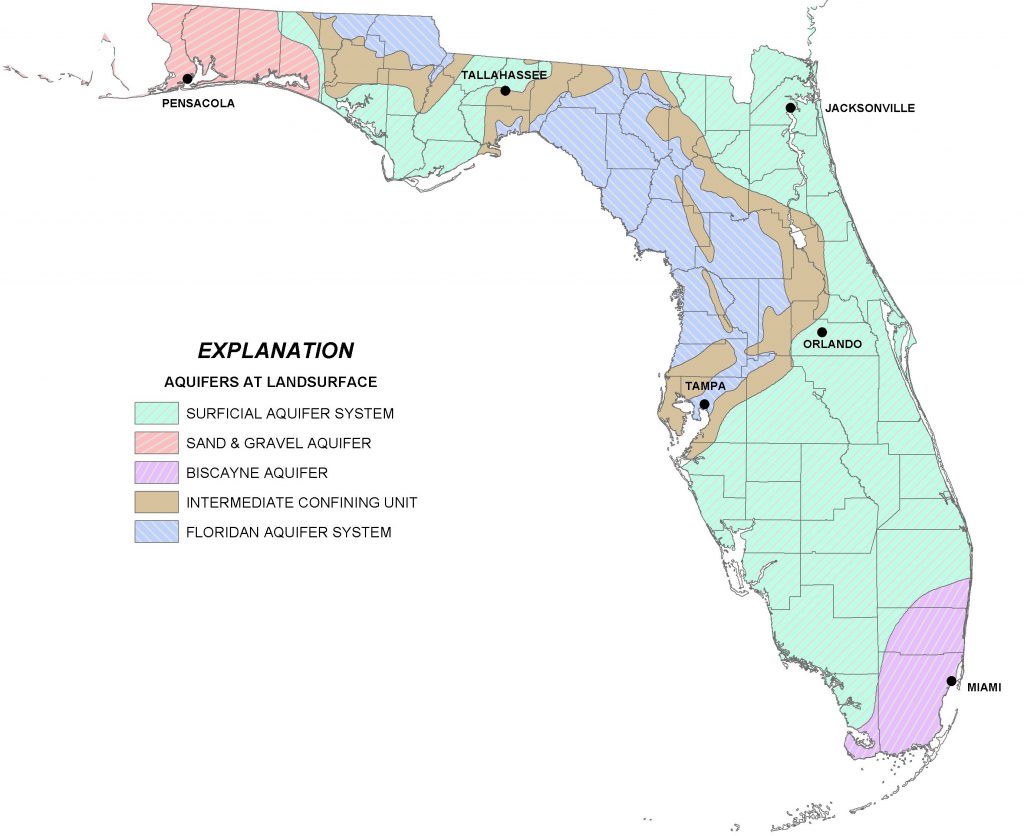
Figure 2. A map of four major aquifer systems in the state of Florida at land surface. The Floridan Aquifer (in blue) underlies the entire state, but in areas north and east of Tampa it is found at the surface. The Surficial (green), Sand and Gravel (red), and Biscayne Aquifer (purple/pink) lie on top of the Floridan Aquifer. A confining unit (area in brown) consists of impermeable materials like thick layers of fine clay that prevent water from easily moving through it. Source: FDEP.
All of the aquifer systems in Florida are recharged by rainfall. In general, freshwater from deeper portions of the aquifer tends to have better water quality than surficial systems, since it is less susceptible to pollution from land surfaces. But, in areas where groundwater is excessively pumped or wells are drilled too deeply, saltwater intrusion occurs. This is where the underlying, denser saltwater replaces the pumped freshwater. Florida’s highly populated coastal areas are particularly susceptible to saltwater intrusion, and this is one of the main reasons that water conservation is a major priority in Florida.
More information about the Floridan Aquifer System and overlying aquifers can be found at the Florida Department of Environmental Protection (https://fldep.dep.state.fl.us/swapp/Aquifer.asp#P4) and in the UF EDIS Publication ‘Florida’s Water Reosurces’ by T. Borisova and T. Wade (https://edis.ifas.ufl.edu/fe757).
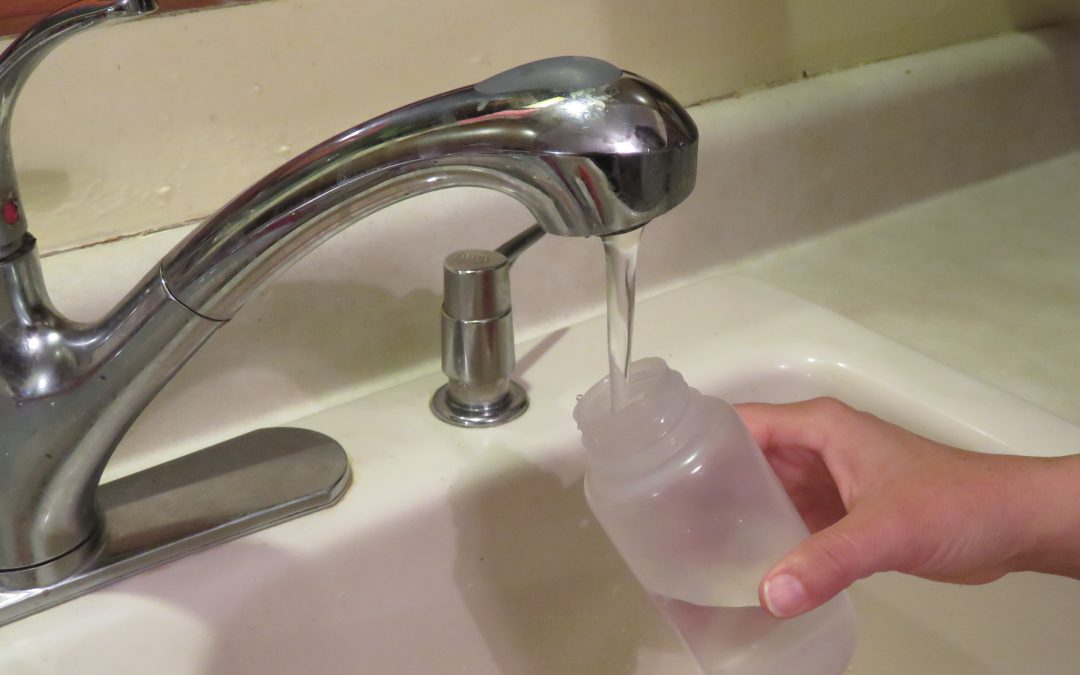
by Andrea Albertin | Jan 31, 2020
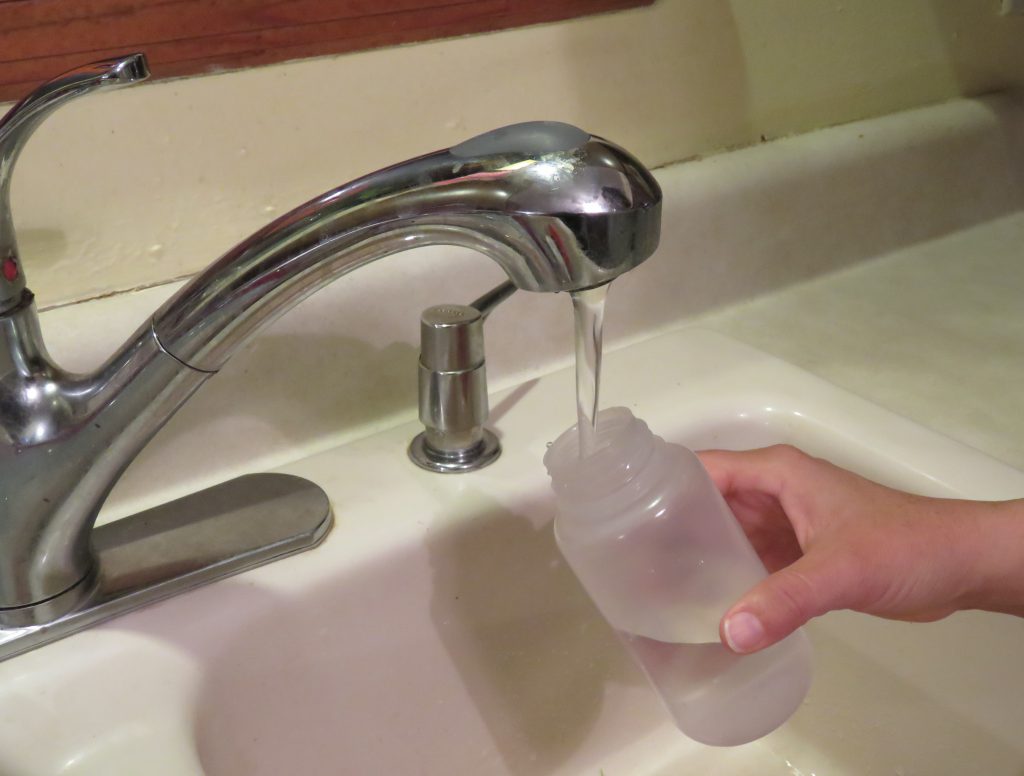
Contact you local county health department office for information on how to test your well water. Image: F. Alvarado Arce
Residents that rely on private wells for home consumption are responsible for ensuring the safety of their own drinking water. The Florida Department of Health (FDOH) recommends private well users test their water once a year for bacteria and nitrate.
Unlike private wells, public water supply systems in Florida are tested regularly to ensure that they are meeting safe drinking water standards.
Where can you have your well water tested?
Your best source of information on how to have your water tested is your local county health department. Most health departments test drinking water and they will let you know exactly what samples need to taken and ho w to submit a sample. You can also submit samples to a certified private lab near you.
Contact information for county health departments can be located at: http://www.floridahealth.gov/programs-and-services/county-health-departments/find-a-county-health-department/index.html
Contact information for private certified laboratories are found at https://fldeploc.dep.state.fl.us/aams/loc_search.asp
Why is it important to test for bacteria?
Labs commonly test for both total coliform bacteria and fecal coliforms (or E. coli specifically). This usually costs about $25 to $30, but can vary depending on where you have your sample analyzed.
- Coliform bacteria are a large, diverse group of bacteria and most species are harmless. But, a positive test for total coliforms shows that bacteria are getting into your well water. They are used as indicators – if coliform bacteria are present, other pathogens that cause diseases may also be getting into your well water. It is easier and cheaper to test for total coliforms than to test for a suite of bacteria and other organisms that can cause health problems.
- Fecal coliform bacteria are a subgroup of coliform bacteria found in human and other warm-blooded animal feces, in food and in the environment. E. coli are one group of fecal coliform bacteria. Most strains of E. coli are harmless, but some strains can cause diarrhea, urinary tract infections, and respiratory illnesses among others.
To ensure safe drinking water, FDOH strongly recommends disinfecting your well if the water tests positive for (1) only total coliform bacteria, or (2) both total coliform and fecal coliform bacteria (or E. coli). Disinfection is usually done through shock chlorination. You can either hire a well operator in your area to disinfect your well or you can do it yourself. Information for how to shock chlorinate your well can be found at http://www.floridahealth.gov/environmental-health/private-well-testing/_documents/well-water-facts-disinfection.pdf
Why is it important to test for nitrate concentration?
High levels of nitrate in drinking water can be dangerous to infants, and can cause “blue baby syndrome” or methemoglobinemia. This is where nitrate interferes with the blood’s capacity to carry oxygen. The Maximum Contaminant Level (MCL) allowed for nitrate in drinking water is 10 milligrams nitrate per liter of water (mg/L). It is particularly important to test for nitrate if you have a young infant in the home that is drinking well water or when well water is used to make formula to feed the infant.
If test results come back above 10 mg/L nitrate, use water from a tested source (bottled water or water from a public supply) until the problem is addressed. Nitrates in well water can come from fertilizers applied on land surfaces, animal waste and/or human sewage, such as from a septic tank. Have your well inspected by a professional to identify why elevated nitrate levels are in your well water. You can also consider installing a water treatment system, such as reverse osmosis or distillation units to treat the contaminated water. Before having a system installed, contact your local health department for more information.
In addition to once a year, you should also have your well water tested when:
- The color, taste or odor of your well water changes or if you suspect that someone became sick after drinking well water.
- A new well is drilled or if you have had maintenance done on your existing well
- A flood occurred and your well and/or septic tank were affected
Remember: Bacteria and nitrate are not the only parameters that well water is tested for. Call your local health department to discuss your what they recommend you should get the water tested for, because it can vary depending on where you live.
FDOH maintains an excellent website with many resources for private well users at http://www.floridahealth.gov/environmental-health/private-well-testing/index.html, which includes information on potential contaminants and how to maintain your well to ensure the quality of your well water.

by Andrea Albertin | May 3, 2019
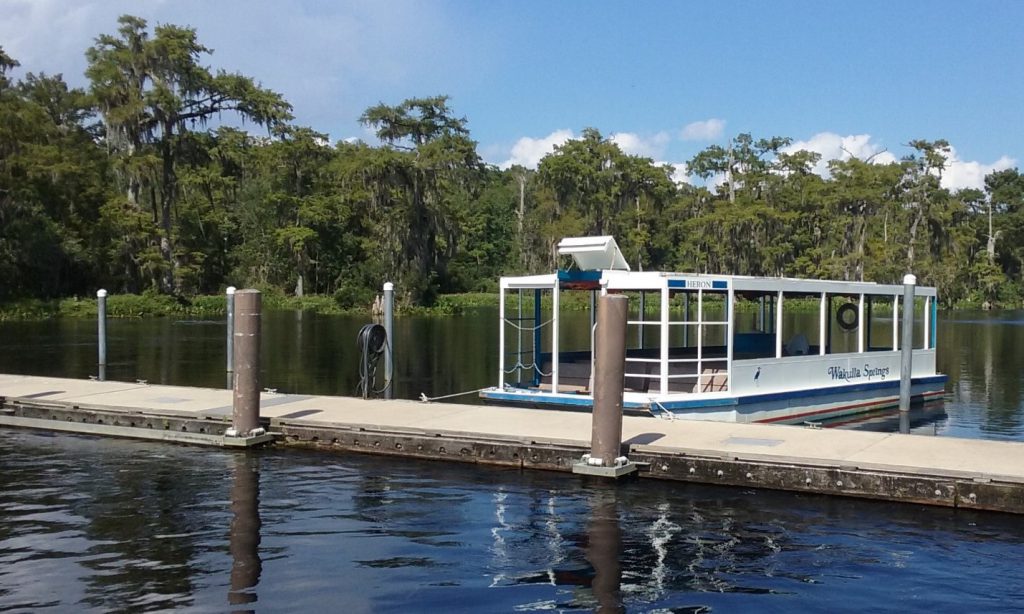
The major goal of the Wakulla Springs Basin Management Action Plan (BMAP) is to reduce nitrogen loads to Wakulla Springs. Septic systems are identified as the primary source of this nitrogen. Photo: A. Albertin
A Basin Management Action Plan, or BMAP, is a management plan developed for a waterbody (like a spring, river, lake, or estuary) that does not meet the water quality standards set by the state. One or more pollutants can impair a waterbody. In Florida, the most common pollutants are nutrients (particularly nitrate), pathogens (fecal coliform bacteria) and mercury.
The goal of the BMAP is to reduce the pollutant load to meet water quality standards set by the Florida Department of Environmental Protection (FDEP). BMAPS are roadmaps with a list of projects and management action items to reach these standards. FDEP develops them with stakeholder input. Targets are set at 20 years, and progress towards those targets is assessed every five years.
It’s important to understand that a BMAP encompasses the entire land area that contributes water to a given waterbody. For example, the land area that contributes water to Jackson Blue Springs and Merritts Mill Pond (either from surface waters or groundwater flow) is 154 square miles, while the Wakulla Springs Basin covers an area of 1,325 square miles.
BMAPs in the Panhandle
There are 33 adopted BMAPS in the state, and 5 that are pending adoption. Here in the Panhandle, we have three adopted BMAPS. They are the Bayou Chico BMAP in Escambia County, the Wakulla Springs BMAP in Wakulla, Leon, Gadsden and small parts of Jefferson County, and the Jackson Blue/Merritts Mill Pond BMAP in Jackson County. All three are impaired for different reasons.
- Bayou Chico discharges into Pensacola Bay and is polluted by fecal coliform bacteria. The BMAP addresses ways to reduce coliforms from humans and pets, which includes sewer expansion projects, stormwater runoff management, septic tank inspections, pet waste ordinances and a Clean Marina and Boatyard program.
- Wakulla Springs Nitrate from human waste is the main pollutant to Wakulla Springs, and Tallahassee’s wastewater treatment facility and the city’s Southeast Sprayfield were identified as the main sources. Both sites were upgraded (the sprayfield was moved), greatly reducing nitrate contributions to the spring basin. The BMAP is focused on septic systems and septic to sewer hookups.
- Jackson Blue/Merritts Mill Pond Nitrate is also the primary pollutant to the Jackson Blue/Merritts Mill Pond Basin, but nitrogen fertilizer from agriculture is identified as the main source. This BMAP focuses on farmers implementing Best Management Practices (BMPs), land acquisition by the Northwest Florida Water Management District , as well as septic tanks, recognizing their nitrogen contribution to Merritts Mill Pond.
Once all the BMAPS are adopted, FDEP states that almost 14 million acres will be under active basin management, an area that includes more than 6.5 million Floridians.
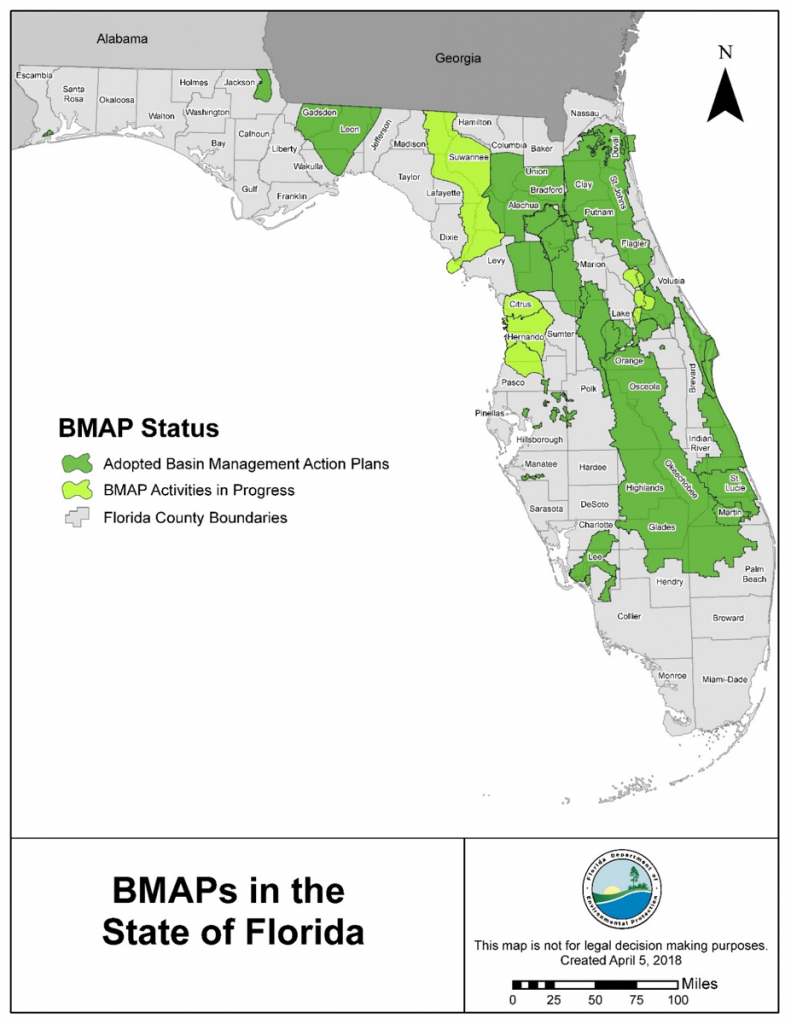
Adopted and pending BMAPS in Florida. Source: FDEP Statewide Annual Report, June 2018
How are residents living in an area with a BMAP affected? It varies by BMAP and specifically land use within its boundaries. For example, in BMAPs where nitrogen from septic systems are found to be a major source of nutrient impairment to a water body, septic to sewer hookups, or septic system upgrades to more advanced treatment units will be required in specific areas. In urban areas where nitrogen fertilizer is an important source, municipalities are required to adopt fertilizer ordinances. Where nitrogen fertilizer from agricultural production is a major source of impairment, producers are required to implement Best Management Practices to reduce nitrogen loads.
More information about BMAPS
For specific information on BMAPS, FDEP has an excellent website: https://floridadep.gov/dear/water-quality-restoration/content/basin-management-action-plans-bmaps All BMAPs (full reports with specific action items listed) can be found there, along with maps, information about upcoming meetings and webinars and other pertinent information.
Your local Health Department Office is the best resource regarding septic systems and any ordinances that may apply to you depending on where you live. Your Water Management District (in the Panhandle it’s the Northwest Florida Water Management District) is also an excellent resource and staff can let you know whether or not you live or farm in an area with a BMAP and how that may affect you.
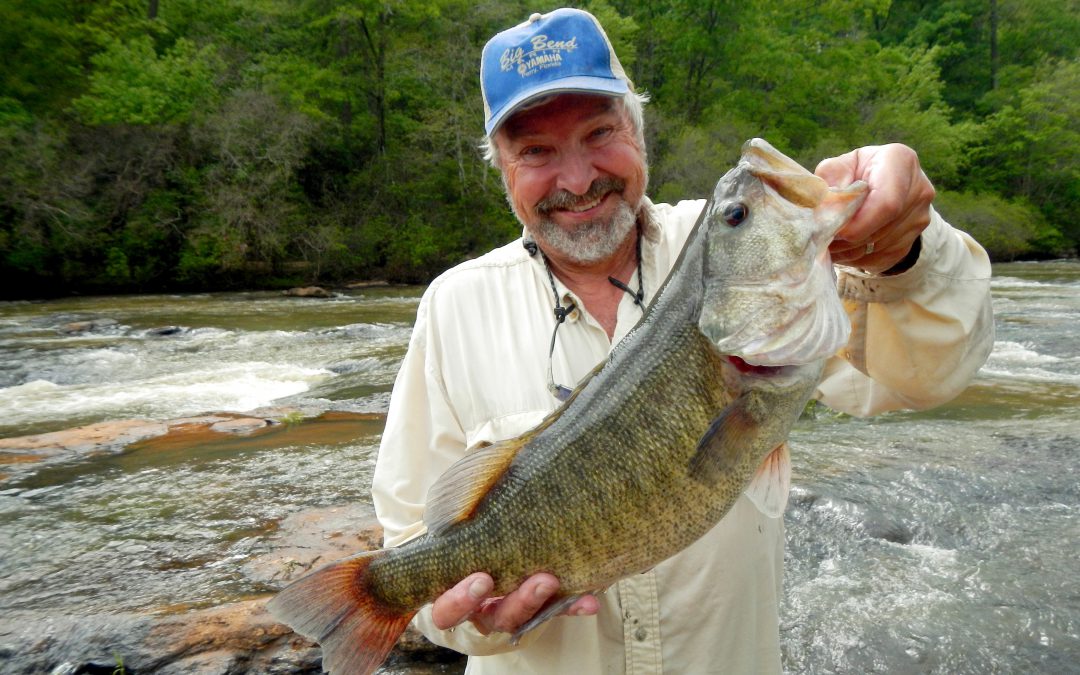
by Andrea Albertin | Mar 20, 2019
By Vance Crain and Andrea Albertin
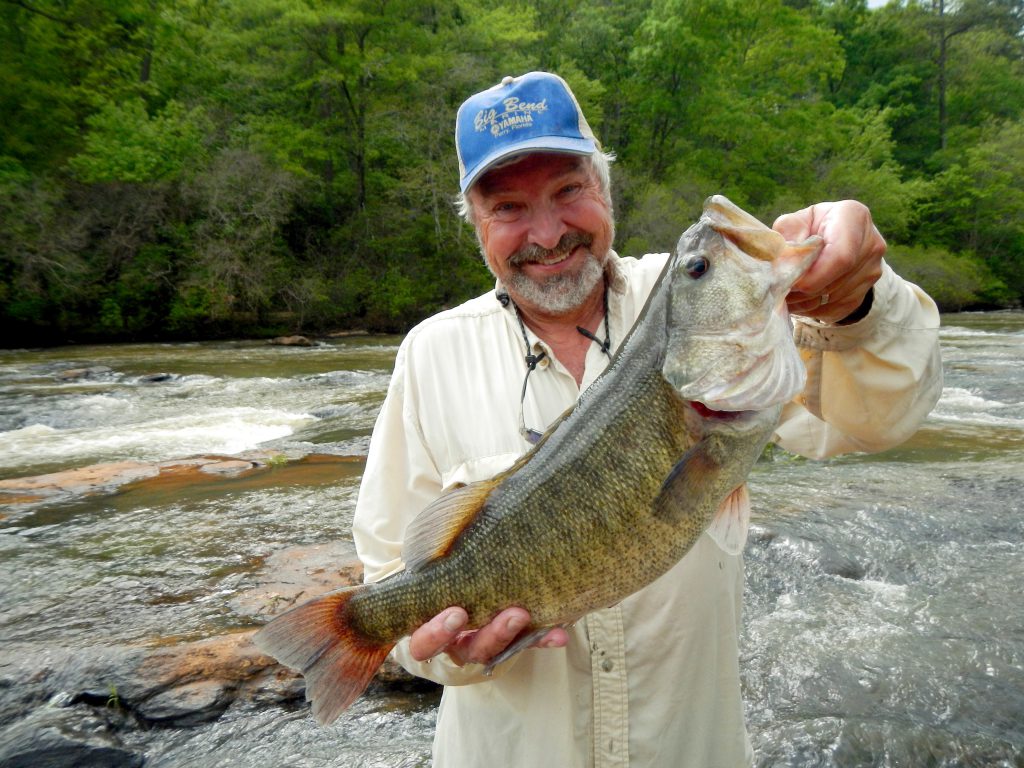
Fisherman with a large Shoal Bass in the Apalachicola-Chattahootchee-Flint River Basin. Photo credit: S. Sammons
Along the Chipola River in Florida’s Panhandle, farmers are doing their part to protect critical Shoal Bass habitat by implementing agricultural Best Management Practices (BMPs) that reduce sediment and nutrient runoff, and help conserve water.
Florida’s Shoal Bass
Lurking in the clear spring-fed Chipola River among limerock shoals and eel grass, is a predatory powerhouse, perfectly camouflaged in green and olive with tiger stripes along its body. The Shoal Bass (a species of Black Bass) tips the scale at just under 6 lbs. But what it lacks in size, it makes up for in power. Unlike any other bass, and found nowhere else in Florida, anglers travel long distances for a chance to pursue it. Floating along the swift current, rocks, and shoals will make you feel like you’ve been transported hundreds of miles away to the Georgia Piedmont, and it’s only the Live Oaks and palms overhanging the river that remind you that you’re still in Florida, and in a truly unique place.
Native to only one river basin in the world, the Apalachicola-Chattahoochee-Flint (ACF) River Basin, habitat loss is putting this species at risk. The Shoal Bass is a fluvial specialist, which means it can only survive in flowing water. Dams and reservoirs have eliminated habitat and isolated populations. Sediment runoff into waterways smothers habitat and prevents the species from reproducing.
In the Chipola River, the population is stable but its range is limited. Some of the most robust Shoal Bass numbers are found in a 6.5-mile section between the Peacock Bridge and Johnny Boy boat ramp. The Florida Fish and Wildlife Conservation Commission has turned this section into a Shoal Bass catch and release only zone to protect the population. However, impacts from agricultural production and ranching, like erosion and nutrient runoff can degrade the habitat needed for the Shoal Bass to spawn.
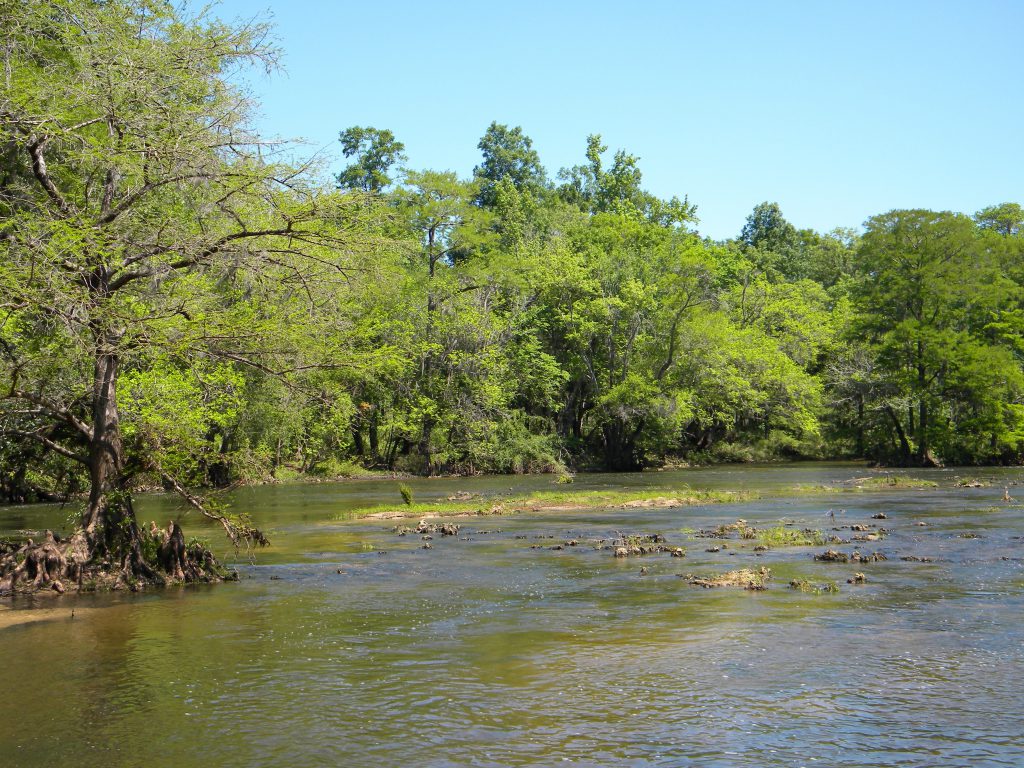
Preferred Shoal Bass habitat, a shoal in the Chipola River. Photo credit: V. Crain
Shoal Bass habitat conservation and BMPs
In 2010, the Southeast Aquatic Resources Partnership (SARP), the National Fish and Wildlife Foundation and a group of scientists (the Black Bass Committee) developed the Native Black Bass Initiative. The goal of the initiative is to increase research and the protection of three Black Bass species native to the Southeast, including the Shoal Bass. It also defined the Shoal Bass as a keystone species, meaning protection of this apex predators’ habitat benefits a host of other threatened and endangered species.
Along the Chipola River, farmers are teaming up with SARP and other partners to protect Shoal Bass habitat and improve farming operations through BMP implementation. A major goal is to protect the river’s riparian zones (the areas along the borders). When healthy, these areas act like sponges by absorbing nutrients and sediment runoff. Livestock often degrade riparian zones by trampling vegetation and destroying the streambank when they go down to a river to drink. Farmers are installing alternative water supplies, like water wells and troughs in fields, and fencing out cattle from waterways to protect these buffer areas and improve water quality. Row crop farmers are helping conserve water in the river basin by using advanced irrigation technologies like soil moisture sensors to better inform irrigation scheduling and variable rate irrigation to increase irrigation efficiency. Cost-share funding from SARP, the USDA-NRCS and FDACS provide resources and technical expertise for farmers to implement these BMPs.

Holstein drinking from a water trough in the field, instead of going down to the river to get water which can cause erosion and problems with water quality. Photo credit: V. Crain
By working together in the Chipola River Basin, farmers, fisheries scientists and resource managers are helping ensure that critical habitat for Shoal Bass remains healthy. Not only is this important for the species and resource, but it will ensure that future generations can continue to enjoy this unique river and seeing one of these fish. So the next time you catch a Shoal Bass, thank a farmer.
For more information about BMPs and cost-share opportunities available for farmers and ranchers, contact your local FDACS field technician: https://www.freshfromflorida.com/Divisions-Offices/Agricultural-Water-Policy/Organization-Staff and NRCS field office USDA-NRCS field office: https://www.nrcs.usda.gov/wps/portal/nrcs/main/fl/contact/local/ For questions regarding the Native Black Bass Initiative or Shoal Bass habitat conservation, contact Vance Crain at vance@southeastaquatics.net
Vance Crain is the Native Black Bass Initiative Coordinator for the Southeast Aquatic Resource Partnership (SARP).
by Andrea Albertin | Jun 8, 2018
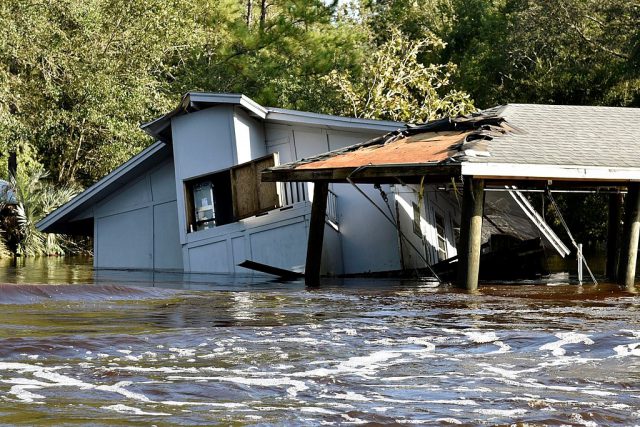
Flooding along the South Prong of the Black Creek River in Clay County on September 13, 2017. Photo credit: Tim Donovan, Florida Fish and Wildlife Conservation Commission (FWC).
As hurricane season is upon us again, I wanted to share the results of work that UF/IFAS Extension staff did with collaborators from Virginia Tech and Texas A&M University to help private well owners impacted by Hurricanes Irma and Harvey last year. This work highlights just how important it is to be prepared for this year’s hurricane season and to make sure that if flooding does occur, those that depend on private wells for household use take the proper precautions to ensure the safety of their drinking water.
About 2.5 million Floridians (approximately 12% of the population) rely on private wells for home consumption. While public water systems are regulated by the U.S. Environmental Protection Agency to ensure safe drinking water, private wells are not regulated. Private well users are responsible for ensuring the safety of their own water.
Hurricanes Irma and Harvey
In response to widespread damage and flooding caused by Hurricane Harvey in Texas and Irma in Florida in August and September 2017, Virginia Polytechnic Institute and State University (VT) received a Rapid Research Response Grant from the National Science Foundation to offer free well water testing to homeowners impacted by flooding.
They partnered with Texas A&M AgriLife Extension’s Well Owner Network (run by Diane Boellstorff and Drew Gholson) and us, at UF/IFAS Extension to provide this service. The effort at VT was led by members of Marc Edward’s lab in the Civil Engineering Department: Kelsey Pieper, Kristine Mapili, William Rhoads, and Greg House.
VT made 1,200 sampling kits available in Texas and 500 in Florida, and offered free analysis for total coliform bacteria and E. coli as well as other parameters, including nitrate, lead, arsenic, iron, chloride, sodium, manganese, copper, fluoride, sulfate, and hardness (calcium and magnesium). Homeowners were also asked to complete a needs assessment questionnaire regarding their well system characteristics, knowledge of proper maintenance and testing, perceptions of the safety of their water and how to best engage them in future outreach and education efforts.
Response in the aftermath of Irma
Although the sampling kits were available, a major challenge in the wake of Irma was getting the word out as counties were just beginning to assess damage and many areas were without power. We coordinated the sampling effort out of Quincy, Florida, where I am based, and spread the word to extension agents in the rest of the state primarily through a group texting app, by telephone and by word of mouth. Extension agents in 6 affected counties (Lee, Pasco, Sarasota, Marion, Clay and Putnam) responded with a need for sample kits, and they in turn advertised sampling to their residents through press releases.
Residents picked up sampling kits and returned water samples and surveys on specified days and the samples were shipped overnight and analyzed at VT, in Blacksburg, VA. Anyone from nearby counties was welcome to submit samples as well. This effort complemented free well water sampling offered by multiple county health departments throughout the state.
In all, 179 water samples from Florida were analyzed at VT and results of the bacterial analysis are shown in the table below. Of 154 valid samples, 58 (38%) tested positive for total coliform bacteria, and 3 (2%) tested positive for E. coli. Results of the inorganic parameters and the needs assessment questionnaire are still being analyzed.
Table 1. Bacterial analysis of private wells in Florida after Hurricane Irma.
| County |
Number of samples (n) |
Positive for total coliform (n) |
Positive total coliform (%) |
Positive for E. coli (n) |
Positive for E. coli (%) |
| Citrus |
1 |
0 |
0% |
0 |
0% |
| Clay |
13 |
5 |
38% |
0 |
0% |
| Hernando |
2 |
1 |
50% |
0 |
0% |
| Hillsborough |
1 |
1 |
100% |
0 |
0% |
| Marion |
19 |
5 |
26% |
1 |
5% |
| Monroe |
1 |
0 |
0% |
0 |
0% |
| Pasco |
40 |
19 |
48% |
1 |
3% |
| Putnam |
61 |
19 |
31% |
0 |
0% |
| Sarasota |
16 |
8 |
50% |
1 |
6% |
| Overall |
154 |
58 |
38% |
3 |
2% |
Of 630 samples analyzed in Texas over the course of 7 weeks post-Hurricane Harvey, 293 samples (47% of wells) tested positive for total coliform bacteria and 75 samples (2%) tested positive for E. coli.
What to do if pathogens are found
Following Florida Department of Health (FDOH) guidelines, we recommended well disinfection to residents whose samples tested positive for total coliform bacteria, or both total coliform and E. coli. This is generally done through shock chlorination by either hiring a well operator or by doing it yourself. The FDOH website provides information on potential contaminants, how to shock chlorinate a well and how to maintain your well to ensure the quality of your well water (http://www.floridahealth.gov/environmental-health/private-well-testing/index.html).
UF/IFAS extension agents that led the sampling efforts in their respective counties were: Roy Beckford – Lee County; Brad Burbaugh – Clay County; Whitney Elmore – Pasco County; Sharon Treen – Putnam and Flagler Counties; Abbey Tyrna – Sarasota County and Yilin Zhuang – Marion County.
We at IFAS Extension are working on using results from this sampling effort and the needs assessment questionnaire filled out by residents to develop the UF/IFAS Florida Well Owner Network. Our goal is to provide residents with educational materials and classes to address gaps in knowledge regarding well maintenance, the importance of testing and recommended treatments when pathogens and other contaminants are present.
Remember: Get your well water tested if flooding occurs
It’s important to remember that if any flooding occurs on your property that affects your well and/or septic system, you should have your well water tested in a certified laboratory for pathogens (total coliform bacteria and E. coli) and any other parameters your local health department may recommend.
Most county health departments accept samples for water testing. You can also submit samples to a certified commercial lab near you. Contact your county health department for information about what to have your water tested for and how to take and submit the sample.
Contact information for county health departments can be found online at: http://www.floridahealth.gov/programs-and-services/county-health-departments/find-a-county-health-department/index.html
You can search for laboratories near you certified by FDOH here: https://fldeploc.dep.state.fl.us/aams/loc_search.asp This includes county health department labs as well as commercial labs, university labs and others.
You should also have your well water tested at any time when:
- The color, taste or odor of your well water changes or if you suspect that someone became sick after drinking your well water
- A new well is drilled or if you have had maintenance done on your existing well
Testing well water once a year is good practice to ensure the safety of your household’s drinking water.














